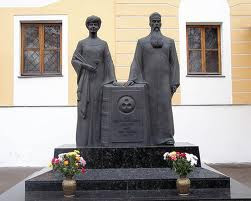We firmly believe that final and stable international peace is achieved only by enlightenment of the people and by permanent and impressive promotion of the brotherhood created by culture, poetry and beauty in all fields of life.
(Nobel Prize Committee on the nomination of Nicholas Roerich for the
1929 Nobel Peace Prize)
I was introduced to the work of Nicholas Roerich by a Russian performance artist in Amsterdam who informed me of his historical Peace Banner and also of the Roerich Pact signed by American president Franklin D. Roosevelt in 1935 and ratified by 36 countries. The Pact at the time had been set-up to protect and define the importance of culture and the protection of cultural values and institutions throughout the global community. (Unfortunately not followed by the US- when the museums of Baghdad were pillaged and not protected upon the Iraq invasion- negating their own historical promise). The Pact did inspire the formation of laws by UNESCO to protect cultural heritages. Roerich was also a significant painter, explorer (who visited many Eastern temples and wrote and painted about them) and a spiritual teacher along with his wife Helena Roerich, the founder of Agni Yoga or Living Ethics. Roerich's Banner of Peace is still a recognized symbol - its trinity of three red dots in a circle - designed to be flown by international cultural institutions and museums to indicate protection and neutrality - like a 'cultural red cross'.
Roerich a major painter and international figure of his time developed a strong friendship with the then US Secretary of the Treasury- Henry A. Wallace which unfortunately led to a scandal when close letters between them were made public by politicians desiring to undermine the Democratic administration. The press made public the 'Guru letters' - it wasn't cool at that time for a politician to be getting advice from a Russian 'mystic'! I'm reminded of a similar controversy in recent times when Hillary Clinton was criticized for her close relationship to futurist Dr. Jean Houston.
Mikhail Gorbachev - who celebrates his 80th birthday at the end of this month at a large event announced in posters currently around London - calls Nicholas Roerich 'one of the cultural pillars of Russia.' The Roerich legacy on peace and culture are preserved at the Roerich museum. You can also learn more about him and his vision at the Center for Peace through Culture.
Roerich was also a 'peace poet' who worked to capture Eastern spiritual thought for Western audiences in his work Flowers of Moria.
I reflect on Roerich's legacy as I work to spread individual's contributed peace poems via flowers in the cities and communities of today. By underlying through culture our basic humanity - our world citizen identity is strengthened. Through creativity and commerce the VPP intends to make visible - as Roerich stated - 'the fundamental quality of the human spirit.'
1929 Nobel Peace Prize)
I was introduced to the work of Nicholas Roerich by a Russian performance artist in Amsterdam who informed me of his historical Peace Banner and also of the Roerich Pact signed by American president Franklin D. Roosevelt in 1935 and ratified by 36 countries. The Pact at the time had been set-up to protect and define the importance of culture and the protection of cultural values and institutions throughout the global community. (Unfortunately not followed by the US- when the museums of Baghdad were pillaged and not protected upon the Iraq invasion- negating their own historical promise). The Pact did inspire the formation of laws by UNESCO to protect cultural heritages. Roerich was also a significant painter, explorer (who visited many Eastern temples and wrote and painted about them) and a spiritual teacher along with his wife Helena Roerich, the founder of Agni Yoga or Living Ethics. Roerich's Banner of Peace is still a recognized symbol - its trinity of three red dots in a circle - designed to be flown by international cultural institutions and museums to indicate protection and neutrality - like a 'cultural red cross'.
Roerich a major painter and international figure of his time developed a strong friendship with the then US Secretary of the Treasury- Henry A. Wallace which unfortunately led to a scandal when close letters between them were made public by politicians desiring to undermine the Democratic administration. The press made public the 'Guru letters' - it wasn't cool at that time for a politician to be getting advice from a Russian 'mystic'! I'm reminded of a similar controversy in recent times when Hillary Clinton was criticized for her close relationship to futurist Dr. Jean Houston.
Mikhail Gorbachev - who celebrates his 80th birthday at the end of this month at a large event announced in posters currently around London - calls Nicholas Roerich 'one of the cultural pillars of Russia.' The Roerich legacy on peace and culture are preserved at the Roerich museum. You can also learn more about him and his vision at the Center for Peace through Culture.
Roerich was also a 'peace poet' who worked to capture Eastern spiritual thought for Western audiences in his work Flowers of Moria.
I reflect on Roerich's legacy as I work to spread individual's contributed peace poems via flowers in the cities and communities of today. By underlying through culture our basic humanity - our world citizen identity is strengthened. Through creativity and commerce the VPP intends to make visible - as Roerich stated - 'the fundamental quality of the human spirit.'


No comments:
Post a Comment